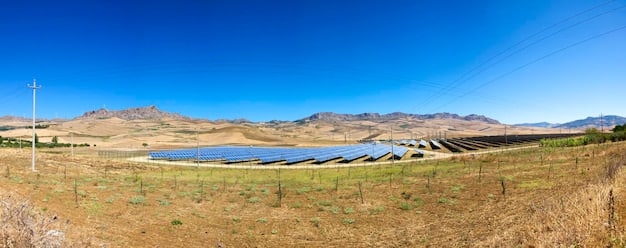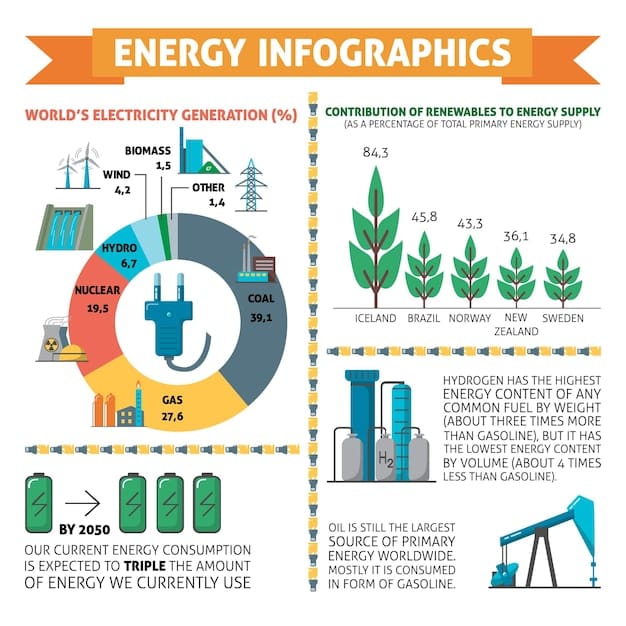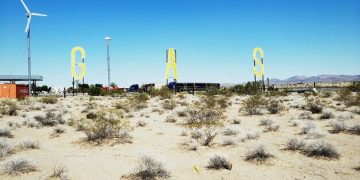Key Policy Changes to Boost the Green Energy Transition in the US

Key policy changes needed to accelerate the transition to a green energy economy in the US include implementing stronger carbon pricing mechanisms, increasing investments in renewable energy infrastructure, and establishing supportive regulatory frameworks for emerging green technologies.
The United States stands at a critical juncture in its energy future. Shifting away from fossil fuels and embracing renewable energy sources is not just an environmental imperative, but also an economic opportunity. The question remains: **what are the key policy changes needed to accelerate the transition to a green energy economy in the US?**
Understanding the Current Energy Landscape in the US
To understand the necessary policy changes, it’s essential to first assess the current energy landscape in the United States. This involves examining the existing energy mix, regulatory environment, and the challenges that hinder the widespread adoption of green energy.
Current Energy Mix and Its Environmental Impact
The US energy mix still heavily relies on fossil fuels like oil, natural gas, and coal. While renewable energy sources have been growing, they still represent a smaller portion of the overall energy supply. This dependence on fossil fuels contributes significantly to greenhouse gas emissions and environmental degradation.
Existing Policies and Regulations
Current US energy policies and regulations vary significantly across states and at the federal level. Some states have implemented renewable portfolio standards and carbon pricing mechanisms, while others lag behind. Navigating this complex landscape is crucial for understanding the scope of policy changes needed.
- Federal tax credits for renewable energy projects
- State-level renewable portfolio standards
- Environmental regulations on emissions from power plants
Overall, the existing energy landscape in the US presents both challenges and opportunities for accelerating the transition to a green energy economy. Supportive policies and regulations are vital to promote renewable energy and reduce greenhouse gas emissions.

Implementing Carbon Pricing Mechanisms
One of the most effective policy changes to accelerate the green energy transition is the implementation of carbon pricing mechanisms. These mechanisms put a price on carbon emissions, incentivizing businesses and individuals to reduce their carbon footprint.
Cap-and-Trade Systems
Cap-and-trade systems set a limit on the total amount of carbon emissions allowed and distribute permits to emitters. These permits can be traded, creating a market for carbon emissions. If a company reduces its emissions beyond the allocated limit, it can sell its permits to other companies.
Carbon Taxes
Carbon taxes, on the other hand, impose a direct tax on carbon emissions. This provides a clear and predictable price signal, encouraging businesses and individuals to invest in cleaner energy alternatives.
- Incentives to reduce carbon emissions
- Revenue generation for green energy projects
- Encouraging innovation in clean technologies
By implementing carbon pricing mechanisms, the US can create economic incentives for reducing carbon emissions and accelerating the shift to a green energy economy.
Increasing Investment in Renewable Energy Infrastructure
Significant investment in renewable energy infrastructure is essential for scaling up the production and distribution of clean energy. This includes investments in solar, wind, hydro, and other renewable energy sources, as well as the infrastructure needed to support them.
Federal Funding and Grants
Increased federal funding and grants for renewable energy projects can help to accelerate their development and deployment. This can include direct funding for research and development, as well as financial incentives for private sector investment.
Public-Private Partnerships
Public-private partnerships can also play a vital role in financing renewable energy infrastructure. By leveraging private sector expertise and capital, these partnerships can help to accelerate the development of large-scale renewable energy projects.

- Job creation in the green energy sector
- Enhanced energy security
- Reduced reliance on fossil fuels
Investing in renewable energy infrastructure is an investment in the future. It not only promotes clean energy but also creates jobs and enhances energy security.
Establishing Supportive Regulatory Frameworks
Supportive regulatory frameworks are essential for promoting the development and deployment of green energy technologies. These frameworks should streamline permitting processes, reduce regulatory barriers, and provide clear guidelines for renewable energy projects.
Streamlining Permitting Processes
Streamlining permitting processes can help to accelerate the development of renewable energy projects. This involves simplifying the application process, reducing bureaucratic hurdles, and ensuring timely decision-making.
Incentivizing Green Technologies
Establishing clear guidelines and regulatory certainty creates a stable environment for investment in green energy technologies. This also reduces risk for investors and developers and fosters innovation.
Establishing supportive regulatory frameworks is crucial for creating a level playing field for renewable energy and encouraging innovation in the green energy sector.
Promoting Energy Efficiency and Conservation
Promoting energy efficiency and conservation is an important aspect of the transition to a green energy economy. By reducing energy consumption, we can lower our carbon footprint and reduce the demand for fossil fuels.
Incentives for Energy Efficiency
Incentives for energy efficiency can include tax credits for energy-efficient appliances, building codes that promote energy conservation, and education programs that encourage energy-saving behaviors.
Investing in Public Transportation
Investments in public transportation can reduce reliance on private vehicles, therefore lowering carbon emissions. Improvements in public transportation can include expanding bus and rail networks and promoting the use of electric buses and trains.
- Reducing energy consumption
- Saving consumers money on energy bills
- Lowering carbon footprint
Promoting energy efficiency and conservation is a cost-effective way to reduce energy demand and lower carbon emissions. It also benefits consumers by reducing energy costs.
Fostering Innovation in Green Technologies
Fostering innovation in green technologies is critical for developing new and improved clean energy solutions. This includes supporting research and development, promoting entrepreneurship, and creating a supportive environment for innovation.
Research and Development
Government funding for research and development can help to drive innovation in green technologies. This can also include funding for university research, national laboratories, and private sector R&D programs.
Entrepreneurship and Start-Ups
Incubator programs and venture capital investments can help to support start-ups developing green technologies. This can include mentorship programs, access to funding, and assistance with business development.
- Developing new clean energy solutions
- Improving the efficiency of existing technologies
- Creating new jobs and economic opportunities
Fostering innovation in green technologies is essential for developing the clean energy solutions needed to address climate change and transition to a sustainable energy economy.
Engaging Communities and Stakeholders
Engaging communities and stakeholders is crucial for building support for the green energy transition. This involves educating the public, addressing concerns, and ensuring that the benefits of clean energy are shared equitably.
Public Education and Awareness
Public education and awareness campaigns can help to promote understanding of the benefits of clean energy and the need for policy changes. This can include outreach programs, public service announcements, and educational resources.
Addressing Concerns and Ensuring Equity
Community meetings and stakeholder consultations can help to address potential concerns and ensure that the benefits of clean energy are shared equitably. This can include addressing concerns about job displacement, environmental impacts, and energy affordability.
Engaging communities and stakeholders is essential for building broad-based support for the green energy transition and ensuring that it benefits all members of society.
| Key Policy | Brief Description |
|---|---|
| 💰 Carbon Pricing | Incentivizes emissions reduction through taxes or cap-and-trade. |
| ⚡ Renewable Investment | Boosts clean energy with funding and public-private partnerships. |
| 📜 Regulation | Streamlines permits and supports green tech innovation. |
| 💡 Efficiency | Promotes energy savings through incentives and public transit. |
Frequently Asked Questions
▼
A green energy economy is one that prioritizes sustainable energy sources, reduces carbon emissions, and minimizes environmental impact while fostering economic growth and job creation.
▼
Transitioning to green energy is crucial to combat climate change, reduce pollution, ensure energy security, and create new economic opportunities in the renewable energy sector.
▼
Carbon pricing mechanisms, like carbon taxes and cap-and-trade systems, put a price on carbon emissions, incentivizing businesses and individuals to reduce their carbon footprint effectively.
▼
Renewable energy infrastructure creates jobs, enhances energy security, reduces reliance on fossil fuels, and reduces air and water pollution, leading to healthier communities.
▼
Public education promotes understanding of the benefits of clean energy and the need for policy changes, helping to build broad-based support for the green energy transition.
Conclusion
Accelerating the transition to a green energy economy in the US requires a multifaceted approach that includes policy changes, investments in infrastructure, and community engagement. By implementing carbon pricing mechanisms, increasing investments in renewable energy, establishing supportive regulatory frameworks, and fostering innovation, the US can create a sustainable and prosperous energy future.





